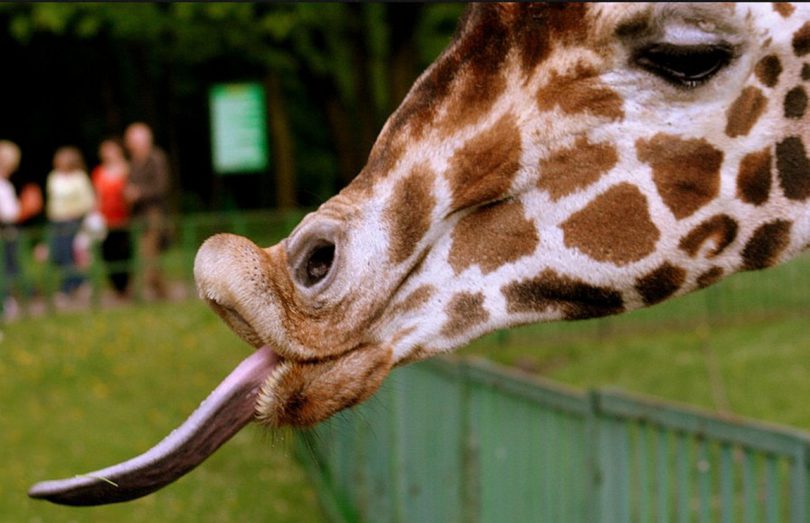Giraffes are some of the most fascinating creatures on Earth. With their long necks, towering legs, and gentle eyes, they often look like something out of a storybook. But if you’ve ever seen a giraffe up close—whether in the wild or at a zoo—you may have noticed another curious feature: their strikingly dark tongues. Usually black, blue, or deep purple in color, giraffe tongues are unlike those of most other animals. But why do they look this way? As it turns out, the unusual color is more than just a quirky trait—it’s a clever adaptation for survival.
Built for Browsing
To understand the giraffe’s tongue, we first need to look at how these giants feed. Giraffes are browsers, which means they spend most of their time eating leaves, twigs, and buds from trees and shrubs. Their favorite delicacy? The leaves of the acacia tree, which are rich in nutrients but protected by sharp thorns.
To reach these leaves, giraffes use their tongues like a precision tool. Measuring an impressive 18 to 20 inches (45 to 50 cm), their tongues are long enough to wrap around branches and skillfully pluck leaves without too much trouble from the thorns. Imagine trying to eat salad with chopsticks that can bend, stretch, and grab—that’s essentially what a giraffe’s tongue does all day long.
The Power of Purple
So where does the tongue’s unusual color come in? Most scientists believe the dark purple (sometimes black or bluish) pigmentation serves an important protective purpose. Giraffes spend hours every day with their tongues exposed, reaching for leaves under the blazing African sun. A lighter-colored tongue, like the pink ones humans and many animals have, would be more prone to sunburn.
The darker pigmentation, which is thought to come from melanin, helps shield their tongues from UV rays. Think of it as nature’s sunscreen built right into their anatomy. This is especially important for an animal that spends 10 to 12 hours a day feeding outdoors.
Not Just About Sun Protection
While UV protection is the most widely accepted explanation, some researchers suggest there may be more to the story. The high levels of melanin might also make the tongue tougher and more resistant to injury. Considering giraffes constantly navigate thorny branches, having a more durable tongue makes a lot of sense.
Additionally, the tongue isn’t entirely purple. If you look closely, the front portion (the part most exposed to the sun) is the darkest, while the back of the tongue—closer to the throat—is pinker. This supports the idea that the darker pigment developed as a form of sun protection where it’s needed most.
A Handy, Slobbery Tool
Another fun fact: giraffe tongues aren’t just long and oddly colored—they’re also extremely strong and flexible. Covered in a thick layer of saliva, the tongue is both tough and slippery, which helps prevent injuries from thorns and allows leaves to slide down easily. The saliva also has antibacterial properties, reducing the risk of infection from any cuts or scrapes caused by prickly plants.
So, in one remarkable package, the giraffe tongue is long, tough, flexible, sun-protected, and self-cleaning. It’s the ultimate all-in-one tool for surviving in the African savanna.
Tongues in Action
If you’ve ever visited a zoo that allows giraffe feeding, you may have had the chance to see this up close. Visitors often hold out carrots or lettuce, only to be greeted by a surprisingly slimy, purple tongue that wraps around the treat with practiced ease. While it can be a little startling, it’s a perfect demonstration of how specialized and efficient giraffe tongues really are.
In the wild, this adaptation ensures giraffes can keep up their high-energy lifestyle. Despite their size, giraffes survive on a diet of mostly leaves, meaning they need to eat a lot—up to 75 pounds (34 kilograms) of food every day. Without their specialized tongues, this would be a nearly impossible task.
More Than a Quirk
At first glance, a purple tongue might seem like just another odd quirk of giraffes, much like their patchy coats or knobby ossicones (the horn-like structures on their heads). But when you look closer, it’s clear this feature plays a critical role in their survival. From protection against the sun to helping them safely navigate thorny meals, the giraffe’s tongue is a shining example of how animals evolve in ingenious ways to adapt to their environments.
A Final Thought
The next time you see a giraffe, don’t just marvel at its height or graceful stride—take a look at its tongue. That unusual splash of purple is more than just a conversation starter. It’s a reminder of how nature equips every creature, big or small, with exactly what it needs to thrive.

